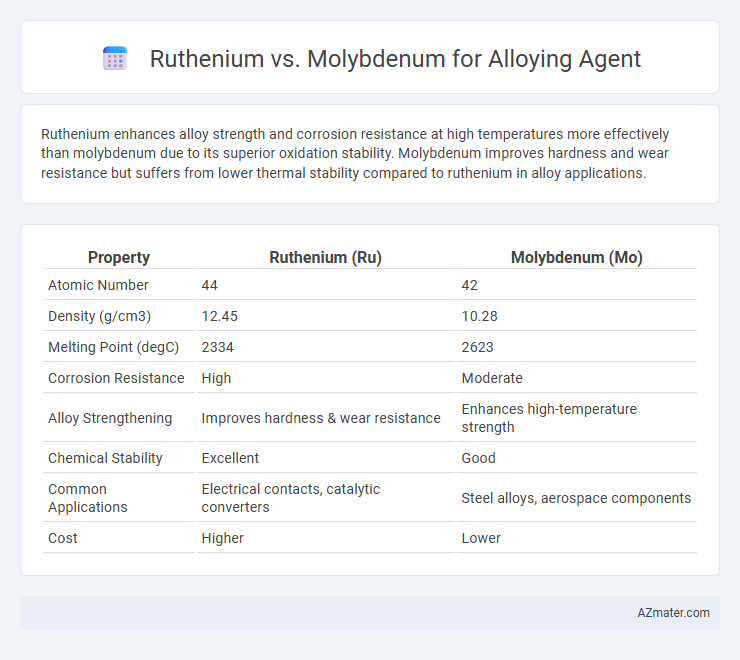Ruthenium enhances alloy strength and corrosion resistance at high temperatures more effectively than molybdenum due to its superior oxidation stability. Molybdenum improves hardness and wear resistance but suffers from lower thermal stability compared to ruthenium in alloy applications.
Table of Comparison
| Property | Ruthenium (Ru) | Molybdenum (Mo) |
|---|---|---|
| Atomic Number | 44 | 42 |
| Density (g/cm3) | 12.45 | 10.28 |
| Melting Point (degC) | 2334 | 2623 |
| Corrosion Resistance | High | Moderate |
| Alloy Strengthening | Improves hardness & wear resistance | Enhances high-temperature strength |
| Chemical Stability | Excellent | Good |
| Common Applications | Electrical contacts, catalytic converters | Steel alloys, aerospace components |
| Cost | Higher | Lower |
Overview of Ruthenium and Molybdenum as Alloying Agents
Ruthenium and molybdenum are transition metals widely used as alloying agents to enhance mechanical strength and corrosion resistance in metals. Ruthenium, part of the platinum group, significantly improves hardness and wear resistance when added in small amounts to platinum, palladium, and titanium alloys. Molybdenum, known for its high melting point and stability, significantly increases toughness and resistance to creep and oxidation, making it essential in steel and superalloys for harsh environments.
Elemental Properties: Ruthenium vs Molybdenum
Ruthenium, a platinum group metal with atomic number 44, exhibits exceptional hardness, corrosion resistance, and a high melting point of 2334degC, making it ideal for enhancing wear resistance in alloys. Molybdenum, atomic number 42, possesses high tensile strength, a melting point of 2623degC, and excellent thermal conductivity, which improves strength and thermal stability in steel and superalloys. The choice between ruthenium and molybdenum as alloying agents depends on desired properties such as corrosion resistance, hardness, and thermal stability in specific industrial applications.
Role in Alloy Strength and Hardness
Ruthenium enhances alloy strength and hardness by refining grain structure and improving phase stability through its strong bonding characteristics, making it particularly effective in superalloys and wear-resistant materials. Molybdenum increases alloy hardness and tensile strength by forming stable carbides and promoting solid solution strengthening, which enhances resistance to creep and high-temperature deformation. Both elements contribute to improved mechanical properties, but ruthenium's unique electronic configuration offers superior benefits in corrosion resistance and high-temperature stability.
Corrosion Resistance Comparison
Ruthenium enhances corrosion resistance in alloys by forming stable oxide layers that prevent surface degradation, especially in aggressive environments such as acidic and oxidizing conditions. Molybdenum also improves corrosion resistance, particularly against pitting and crevice corrosion in chloride-rich environments, making it valuable in stainless steel formulations. When comparing the two, ruthenium tends to provide superior protection in highly oxidative and acidic atmospheres, whereas molybdenum excels in resisting localized corrosion in chloride-heavy contexts.
Influence on Alloy Conductivity
Ruthenium significantly enhances alloy conductivity by improving electron mobility and reducing resistivity, making it a preferred choice in high-performance electrical applications. Molybdenum, while also beneficial, primarily contributes to strength and corrosion resistance but exhibits a comparatively moderate effect on electrical conductivity. Alloys containing ruthenium typically achieve superior conductive properties compared to molybdenum-based alloys, particularly in aerospace and electronic environments.
Cost and Availability Factors
Ruthenium, a rare platinum-group metal, is significantly more expensive than molybdenum due to its limited availability and complex extraction processes. Molybdenum is more abundant in the Earth's crust and widely mined, offering a cost-effective alloying agent for steel and superalloys. Cost-sensitive industries often prefer molybdenum for large-scale applications, while ruthenium's higher price limits its use to specialized, high-performance alloys.
Applications in Industrial Alloys
Ruthenium enhances corrosion resistance and hardness when alloyed with platinum and palladium, making it essential in electrical contacts and catalytic converters. Molybdenum significantly improves strength, toughness, and high-temperature stability in steel alloys used in aerospace, automotive, and construction industries. Both elements play critical roles in developing industrial alloys with superior mechanical properties and resistance to extreme environments.
Environmental and Safety Considerations
Ruthenium, a scarce precious metal, offers excellent corrosion resistance and high-temperature stability but poses environmental concerns due to its limited availability and challenges in recycling processes. Molybdenum is more abundant and safer in handling, with lower toxicity levels and established recycling methods, making it an environmentally preferable choice for alloying applications. Both metals require careful management to minimize environmental impact, especially regarding mining practices and disposal of alloy waste.
Performance in High-Temperature Environments
Ruthenium enhances alloy performance in high-temperature environments by significantly improving oxidation resistance and thermal stability, making it ideal for aerospace and turbine engine applications. Molybdenum offers excellent strength retention and creep resistance at elevated temperatures, commonly used in stainless steels and superalloys for power generation and petrochemical industries. Ruthenium's superior catalytic properties and ability to inhibit grain boundary weakening provide an edge over molybdenum in ultra-high-temperature scenarios exceeding 1000degC.
Choosing the Right Alloying Agent: Ruthenium or Molybdenum
Ruthenium enhances corrosion resistance and hardness in alloys, making it ideal for high-performance applications such as electrical contacts and catalytic converters. Molybdenum offers excellent strength and wear resistance at elevated temperatures, commonly used in steel and superalloys for aerospace and automotive industries. Selecting between ruthenium and molybdenum depends on the specific alloy requirements, including operating environment, mechanical properties, and cost considerations.

Infographic: Ruthenium vs Molybdenum for Alloying Agent
 azmater.com
azmater.com